日本专利法
- 格式:pdf
- 大小:61.09 KB
- 文档页数:21
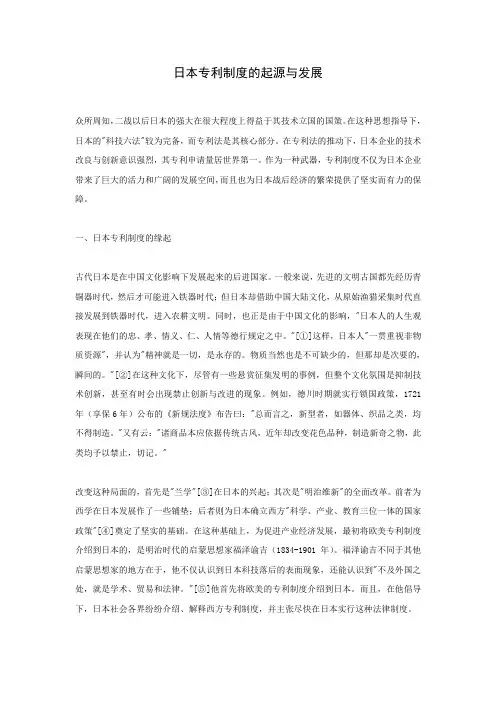
日本专利制度的起源与发展众所周知,二战以后日本的强大在很大程度上得益于其技术立国的国策。
在这种思想指导下,日本的"科技六法"较为完备,而专利法是其核心部分。
在专利法的推动下,日本企业的技术改良与创新意识强烈,其专利申请量居世界第一。
作为一种武器,专利制度不仅为日本企业带来了巨大的活力和广阔的发展空间,而且也为日本战后经济的繁荣提供了坚实而有力的保障。
一、日本专利制度的缘起古代日本是在中国文化影响下发展起来的后进国家。
一般来说,先进的文明古国都先经历青铜器时代,然后才可能进入铁器时代;但日本却借助中国大陆文化,从原始渔猎采集时代直接发展到铁器时代,进入农耕文明。
同时,也正是由于中国文化的影响,"日本人的人生观表现在他们的忠、孝、情义、仁、人情等德行规定之中。
"[①]这样,日本人"一贯重视非物质资源",并认为"精神就是一切,是永存的。
物质当然也是不可缺少的,但那却是次要的,瞬间的。
"[②]在这种文化下,尽管有一些悬赏征集发明的事例,但整个文化氛围是抑制技术创新,甚至有时会出现禁止创新与改进的现象。
例如,德川时期就实行锁国政策,1721年(享保6年)公布的《新规法度》布告曰:"总而言之,新型者,如器体、织品之类,均不得制造。
"又有云:"诸商品本应依据传统古风,近年却改变花色品种,制造新奇之物,此类均予以禁止,切记。
"改变这种局面的,首先是"兰学"[③]在日本的兴起;其次是"明治维新"的全面改革。
前者为西学在日本发展作了一些铺垫;后者则为日本确立西方"科学、产业、教育三位一体的国家政策"[④]奠定了坚实的基础。
在这种基础上,为促进产业经济发展,最初将欧美专利制度介绍到日本的,是明治时代的启蒙思想家福泽谕吉(1834-1901年)。
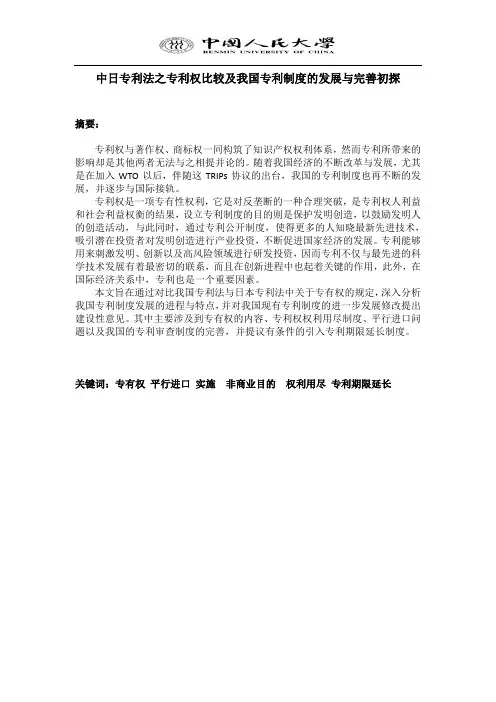
中日专利法之专利权比较及我国专利制度的发展与完善初探摘要:专利权与著作权、商标权一同构筑了知识产权权利体系,然而专利所带来的影响却是其他两者无法与之相提并论的。
随着我国经济的不断改革与发展,尤其是在加入WTO以后,伴随这TRIPs协议的出台,我国的专利制度也再不断的发展,并逐步与国际接轨。
专利权是一项专有性权利,它是对反垄断的一种合理突破,是专利权人利益和社会利益权衡的结果,设立专利制度的目的则是保护发明创造,以鼓励发明人的创造活动,与此同时,通过专利公开制度,使得更多的人知晓最新先进技术,吸引潜在投资者对发明创造进行产业投资,不断促进国家经济的发展。
专利能够用来刺激发明、创新以及高风险领域进行研发投资,因而专利不仅与最先进的科学技术发展有着最密切的联系,而且在创新进程中也起着关键的作用,此外,在国际经济关系中,专利也是一个重要因素。
本文旨在通过对比我国专利法与日本专利法中关于专有权的规定,深入分析我国专利制度发展的进程与特点,并对我国现有专利制度的进一步发展修改提出建设性意见。
其中主要涉及到专有权的内容、专利权权利用尽制度、平行进口问题以及我国的专利审查制度的完善,并提议有条件的引入专利期限延长制度。
关键词:专有权平行进口实施非商业目的权利用尽专利期限延长一、专利制度概述“专利”一词可追溯到2000年前《国语》中“荣公好专利”,是指一个人把“利”独占之意,跟目前“专利”的含义相去甚远。
专利制度是国际上通行的一种利用法律手段推动科学技术进步的管理制度。
这种制度的基本内容是:依据专利法,对申请专利的发明创造经过审查和批准授予专利权,同时把申请专利的发明创造公诸于世,以便于进行发明创造信息交流和有偿技术转让。
1专利制度从其产生开始,就与一国的科学技术发展状况,以及由新技术引起的市场竞争和专利权人的权利紧密的联系在一起,彼此促进,共同发展,使各国技术得以迅速发展。
专利制度的内容主要有以下三个层次:首先,以法律手段保障专利权人的排他性权利。

日本专利法的历史发展(代序)一、日本专利度的缘起古代日本是在化下发展起来的后国家。
一般来说,先进文明古国都先经历青器,然后才可能进入铁器时代;日本却借助中国大陆文化,原始渔猎采集时代直接发到铁器时代,进入耕文明。
同时,也正是由中国文化的影响,”日本人的生观表现在他们的忠、孝、义、仁、人情等德行规定中。
”[①]这样日本人”一贯重视物质资源”,并认为”精就是一切,是永存的物质当然也是不可缺少,但那却是次要的,瞬的。
”[②]在这种文化下,尽有一些悬赏征集发明的事例,整个文化氛围是抑制技术创新甚至有时会出现禁止新与改进的现象。
例如,德时期就实行锁国政策,1721年享保6年)公布的《新规法度》布曰:”总而言之,新型者,如体、织品之类,均不得造。
”又有云:”诸商品本应依传统古风,近年却改变花色品种,造新奇之物,此类予以禁止,切记。
”改变种局面的,首先是”兰学”[③]在日本的兴起;其次是”明治维新”的全面革。
前者为西学在日发展作了一些铺垫后者则为日本确立西方”、产业、位一体的国家政策”[④]奠定了坚实的基。
在这种基础上,为促进产经济发展,最初将欧美专利制度介到日本的,是明治时的启蒙思想家福泽谕吉(1834-1901年)。
福泽谕吉不同于他启蒙思想家的地在于,他不仅认识日本科技落后的表面象,还能认识到”不及外国之处,是学术、贸易和。
”[⑤]他首先将欧美的专利制介绍到日本。
而且,在倡导下,日本各界纷纷介绍、释西方专利制度,并主张尽快在日实行这种法律制度。
1871年(明治4年,日本颁布了《专卖简则》尽管该简则在实行后的第二年就遭了废止,但其仿效欧美专利度,开风气之先,仍为日人称道不已。
《专卖则》共19条。
简则开宗明:”任何物品的发人,在近来专卖御差的管辖下,申请者,均可按规定内民部省提出申请”该简则采取先申请原,允许延长有效期和缓缴专利费,对使用发明和专利标方面作了相关规定。
这些规定突破了传统习俗与禁锢,在当时”一个非常进步的规定”[⑥]。
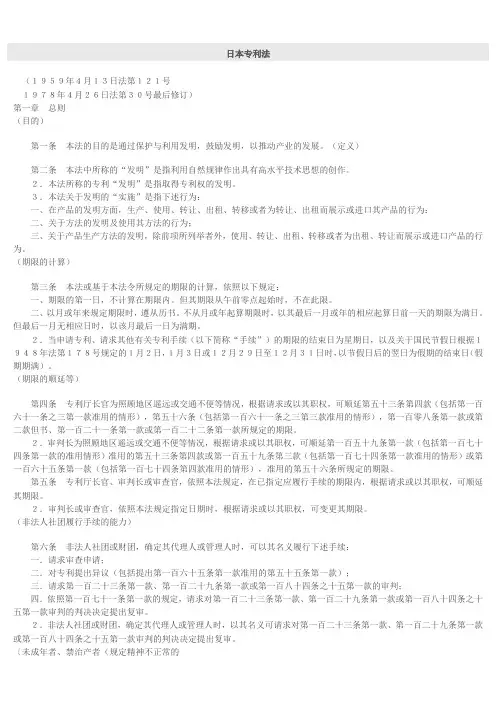
日本专利法(1959年4月13日法第121号1978年4月26日法第30号最后修订)第一章总则(目的)第一条本法的目的是通过保护与利用发明,鼓励发明,以推动产业的发展。
(定义)第二条本法中所称的“发明”是指利用自然规律作出具有高水平技术思想的创作。
2.本法所称的专利“发明”是指取得专利权的发明。
3.本法关于发明的“实施”是指下述行为:一、在产品的发明方面,生产、使用、转让、出租、转移或者为转让、出租而展示或进口其产品的行为:二、关于方法的发明及使用其方法的行为;三、关于产品生产方法的发明,除前项所列举者外,使用、转让、出租、转移或者为出租、转让而展示或进口产品的行为。
(期限的计算)第三条本法或基于本法令所规定的期限的计算,依照以下规定:一、期限的第一日,不计算在期限内。
但其期限从午前零点起始时,不在此限。
二、以月或年来规定期限时,遵从历书。
不从月或年起算期限时,以其最后一月或年的相应起算日前一天的期限为满日。
但最后一月无相应日时,以该月最后一日为满期。
2.当申请专利、请求其他有关专利手续(以下简称“手续”)的期限的结束日为星期日,以及关于国民节假日根据1948年法第178号规定的1月2日,1月3日或12月29日至12月31日时,以节假日后的翌日为假期的结束日(假期期满)。
(期限的顺延等)第四条专利厅长官为照顾地区遥远或交通不便等情况,根据请求或以其职权,可顺延第五十三条第四款(包括第一百六十一条之三第一款准用的情形),第五十六条(包括第一百六十一条之三第三款准用的情形),第一百零八条第一款或第二款但书、第一百二十一条第一款或第一百二十二条第一款所规定的期限。
2.审判长为照顾地区遥远或交通不便等情况,根据请求或以其职权,可顺延第一百五十九条第一款(包括第一百七十四条第一款的准用情形)准用的第五十三条第四款或第一百五十九条第三款(包括第一百七十四条第一款准用的情形)或第一百六十五条第一款(包括第一百七十四条第四款准用的情形),准用的第五十六条所规定的期限。

日本专利法1959年4月13日法第121号1978年4月26日法第30号最后修订)第一章总则(目的)第一条本法的目的是通过保护与利用发明,鼓励发明,以推动产业的发展。
(定义)第二条本法中所称的“发明”是指利用自然规律作出具有高水平技术思想的创作。
2.本法所称的专利“发明”是指取得专利权的发明。
3.本法关于发明的“实施”是指下述行为:一、在产品的发明方面,生产、使用、转让、出租、转移或者为转让、出租而展示或进口其产品的行为:二、关于方法的发明及使用其方法的行为;三、关于产品生产方法的发明,除前项所列举者外,使用、转让、出租、转移或者为出租、转让而展示或进口产品的行为。
(期限的计算)第三条本法或基于本法令所规定的期限的计算,依照以下规定:一、期限的第一日,不计算在期限内。
但其期限从午前零点起始时,不在此限。
二、以月或年来规定期限时,遵从历书。
不从月或年起算期限时,以其最后一月或年的相应起算日前一天的期限为满日。
但最后一月无相应日时,以该月最后一日为满期。
2.当申请专利、请求其他有关专利手续(以下简称“手续”)的期限的结束日为星期日,以及关于国民节假日根据1948年法第178号规定的1月2日,1月3日或12月29日至12月31日时,以节假日后的翌日为假期的结束日(假期期满)。
(期限的顺延等)第四条专利厅长官为照顾地区遥远或交通不便等情况,根据请求或以其职权,可顺延第五十三条第四款(包括第一百六十一条之三第一款准用的情形),第五十六条(包括第一百六十一条之三第三款准用的情形),第一百零八条第一款或第二款但书、第一百二十一条第一款或第一百二十二条第一款所规定的期限。
2.审判长为照顾地区遥远或交通不便等情况,根据请求或以其职权,可顺延第一百五十九条第一款(包括第一百七十四条第一款的准用情形)准用的第五十三条第四款或第一百五十九条第三款(包括第一百七十四条第一款准用的情形)或第一百六十五条第一款(包括第一百七十四条第四款准用的情形),准用的第五十六条所规定的期限。
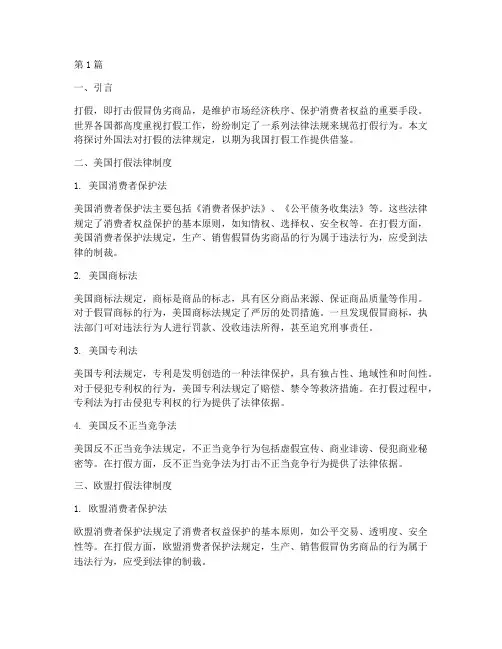
第1篇一、引言打假,即打击假冒伪劣商品,是维护市场经济秩序、保护消费者权益的重要手段。
世界各国都高度重视打假工作,纷纷制定了一系列法律法规来规范打假行为。
本文将探讨外国法对打假的法律规定,以期为我国打假工作提供借鉴。
二、美国打假法律制度1. 美国消费者保护法美国消费者保护法主要包括《消费者保护法》、《公平债务收集法》等。
这些法律规定了消费者权益保护的基本原则,如知情权、选择权、安全权等。
在打假方面,美国消费者保护法规定,生产、销售假冒伪劣商品的行为属于违法行为,应受到法律的制裁。
2. 美国商标法美国商标法规定,商标是商品的标志,具有区分商品来源、保证商品质量等作用。
对于假冒商标的行为,美国商标法规定了严厉的处罚措施。
一旦发现假冒商标,执法部门可对违法行为人进行罚款、没收违法所得,甚至追究刑事责任。
3. 美国专利法美国专利法规定,专利是发明创造的一种法律保护,具有独占性、地域性和时间性。
对于侵犯专利权的行为,美国专利法规定了赔偿、禁令等救济措施。
在打假过程中,专利法为打击侵犯专利权的行为提供了法律依据。
4. 美国反不正当竞争法美国反不正当竞争法规定,不正当竞争行为包括虚假宣传、商业诽谤、侵犯商业秘密等。
在打假方面,反不正当竞争法为打击不正当竞争行为提供了法律依据。
三、欧盟打假法律制度1. 欧盟消费者保护法欧盟消费者保护法规定了消费者权益保护的基本原则,如公平交易、透明度、安全性等。
在打假方面,欧盟消费者保护法规定,生产、销售假冒伪劣商品的行为属于违法行为,应受到法律的制裁。
2. 欧盟知识产权法欧盟知识产权法包括商标法、专利法、著作权法等。
这些法律规定了知识产权的保护范围、保护期限和保护措施。
在打假方面,欧盟知识产权法为打击侵犯知识产权的行为提供了法律依据。
3. 欧盟反不正当竞争法欧盟反不正当竞争法规定,不正当竞争行为包括虚假宣传、商业诽谤、侵犯商业秘密等。
在打假方面,欧盟反不正当竞争法为打击不正当竞争行为提供了法律依据。
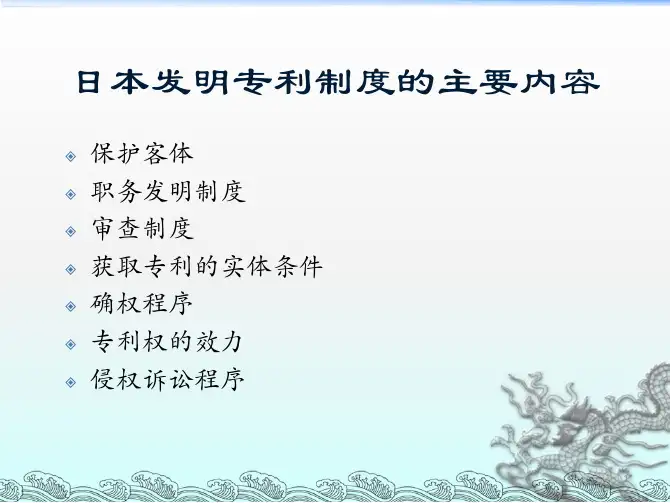

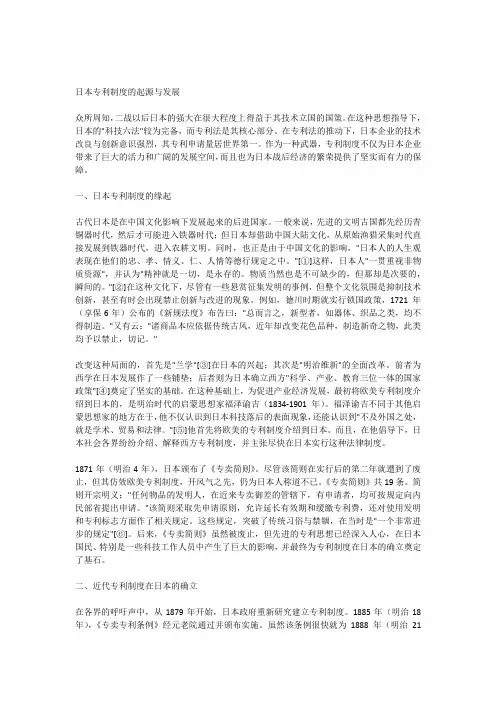
日本专利制度的起源与发展众所周知,二战以后日本的强大在很大程度上得益于其技术立国的国策。
在这种思想指导下,日本的"科技六法"较为完备,而专利法是其核心部分。
在专利法的推动下,日本企业的技术改良与创新意识强烈,其专利申请量居世界第一。
作为一种武器,专利制度不仅为日本企业带来了巨大的活力和广阔的发展空间,而且也为日本战后经济的繁荣提供了坚实而有力的保障。
一、日本专利制度的缘起古代日本是在中国文化影响下发展起来的后进国家。
一般来说,先进的文明古国都先经历青铜器时代,然后才可能进入铁器时代;但日本却借助中国大陆文化,从原始渔猎采集时代直接发展到铁器时代,进入农耕文明。
同时,也正是由于中国文化的影响,"日本人的人生观表现在他们的忠、孝、情义、仁、人情等德行规定之中。
"[①]这样,日本人"一贯重视非物质资源",并认为"精神就是一切,是永存的。
物质当然也是不可缺少的,但那却是次要的,瞬间的。
"[②]在这种文化下,尽管有一些悬赏征集发明的事例,但整个文化氛围是抑制技术创新,甚至有时会出现禁止创新与改进的现象。
例如,德川时期就实行锁国政策,1721年(享保6年)公布的《新规法度》布告曰:"总而言之,新型者,如器体、织品之类,均不得制造。
"又有云:"诸商品本应依据传统古风,近年却改变花色品种,制造新奇之物,此类均予以禁止,切记。
"改变这种局面的,首先是"兰学"[③]在日本的兴起;其次是"明治维新"的全面改革。
前者为西学在日本发展作了一些铺垫;后者则为日本确立西方"科学、产业、教育三位一体的国家政策"[④]奠定了坚实的基础。
在这种基础上,为促进产业经济发展,最初将欧美专利制度介绍到日本的,是明治时代的启蒙思想家福泽谕吉(1834-1901年)。
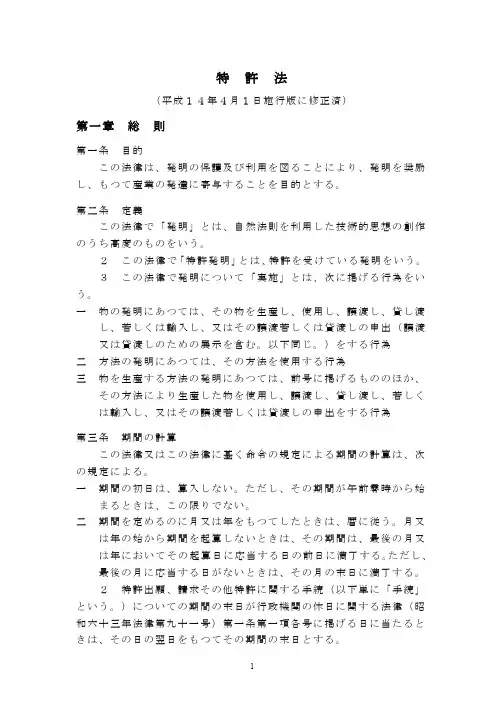
特 許 法(平成14年4月1日施行版に修正済)第一章 総 則第一条 目的この法律は、発明の保護及び利用を図ることにより、発明を奨励し、もつて産業の発達に寄与することを目的とする。
第二条 定義この法律で「発明」とは、自然法則を利用した技術的思想の創作のうち高度のものをいう。
2 この法律で「特許発明」とは、特許を受けている発明をいう。
3 この法律で発明について「実施」とは、次に掲げる行為をいう。
一 物の発明にあつては、その物を生産し、使用し、譲渡し、貸し渡し、若しくは輸入し、又はその譲渡若しくは貸渡しの申出(譲渡又は貸渡しのための展示を含む。
以下同じ。
)をする行為二 方法の発明にあつては、その方法を使用する行為三 物を生産する方法の発明にあつては、前号に掲げるもののほか、その方法により生産した物を使用し、譲渡し、貸し渡し、若しくは輸入し、又はその譲渡若しくは貸渡しの申出をする行為第三条 期間の計算この法律又はこの法律に基く命令の規定による期間の計算は、次の規定による。
一 期間の初日は、算入しない。
ただし、その期間が午前零時から始まるときは、この限りでない。
二 期間を定めるのに月又は年をもつてしたときは、暦に従う。
月又は年の始から期間を起算しないときは、その期間は、最後の月又は年においてその起算日に応当する日の前日に満了する。
ただし、最後の月に応当する日がないときは、その月の末日に満了する。
2 特許出願、請求その他特許に関する手続(以下単に「手続」という。
)についての期間の末日が行政機関の休日に関する法律(昭和六十三年法律第九十一号)第一条第一項各号に掲げる日に当たるときは、その日の翌日をもつてその期間の末日とする。
第四条 期間の延長等特許庁長官は、遠隔又は交通不便の地にある者のため、請求により又は職権で、第百八条第一項、第百二十一条第一項又は第百七十三条第一項に規定する期間を延長することができる。
第五条 期間の延長等特許庁長官、審判長又は審査官は、この法律の規定により手続をすべき期間を指定したときは、請求により又は職権で、その期間を延長することができる。
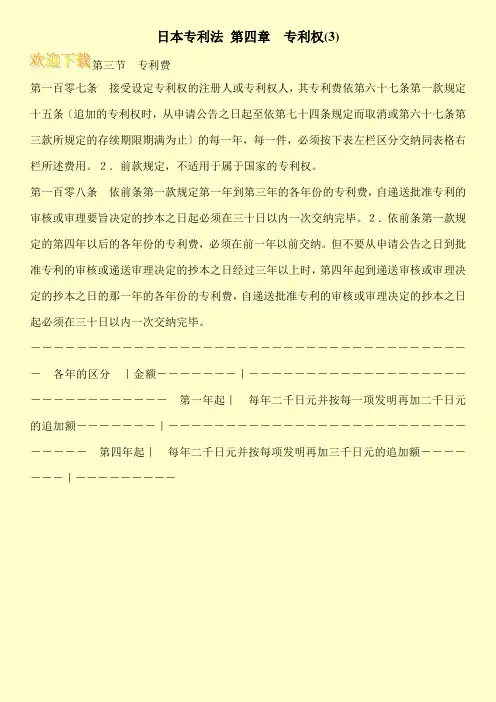
日本专利法第四章专利权(3)
第三节专利费
第一百零七条接受设定专利权的注册人或专利权人,其专利费依第六十七条第一款规定十五条〔追加的专利权时,从申请公告之日起至依第七十四条规定而取消或第六十七条第三款所规定的存续期限期满为止〕的每一年,每一件,必须按下表左栏区分交纳同表格右栏所述费用。
2.前款规定,不适用于属于国家的专利权。
第一百零八条依前条第一款规定第一年到第三年的各年份的专利费,自递送批准专利的审核或审理要旨决定的抄本之日起必须在三十日以内一次交纳完毕。
2.依前条第一款规定的第四年以后的各年份的专利费,必须在前一年以前交纳。
但不要从申请公告之日到批准专利的审核或递送审理决定的抄本之日经过三年以上时,第四年起到递送审核或审理决定的抄本之日的那一年的各年份的专利费,自递送批准专利的审核或审理决定的抄本之日起必须在三十日以内一次交纳完毕。
---------------------------------------各年的区分|金额-------|-------------------------------第一年起|每年二千日元并按每一项发明再加二千日元的追加额-------|-------------------------------第四年起|每年二千日元并按每项发明再加三千日元的追加额-------|---------。
日本《专利法》第104条之3对我国的启示
易玲
【期刊名称】《科技与法律》
【年(卷),期】2013(000)003
【摘要】知识产权确权问题取决于行政权与司法权的分配与制衡,而我国的这两大权力配置不合理,其突出体现在,专利侵权诉讼与无效审理程序并存时,由于法官的自由裁量权过弱产生中止诉讼等问题。
而日本《专利法》第104条之3意义重大,这一条款虽然没有明确法院直接宣告专利权无效的权力,但是实质上已变相地赋予法院在无效抗辩中间接的裁判权,对中国起着较大的示范作用。
结合国情和现实背景,中国应借鉴日本的有益做法,对专利侵权诉讼中止问题重新梳理,合理配置行政权与司法权,适当扩大法官自由裁量权的边界,建立专利无效宣告程序与诉讼的协调机制。
【总页数】9页(P45-53)
【作者】易玲
【作者单位】湖南工业大学,湖南株洲412000
【正文语种】中文
【中图分类】D923.42
【相关文献】
1.日本与《专利法条约》相适应的法律制度调整浅析
2.关于中国专利法第二十六条第四款与日本专利法相关规定的比较(上)
3.关于中国《专利法》第26条第4款与
日本专利法相关规定的比较(下)4.英国旭化成案对专利优先权实质条件的认定及对我国的启示——兼论我国《专利法》第二十九条的修订5.美国专利法的域外适用及对我国的启示
因版权原因,仅展示原文概要,查看原文内容请购买。
日本专利申请制度介绍日本是我国第一大的出口国,贸易总额最大,所以也应优先考虑。
日本在很多电子通信技术方面世界领先,有的产品有我国的厂商有竞争关系,是国际市场上之劲敌,所以它们在中国专利布网比较积极。
同时申请发明或者实用新型,只能授权其一。
在无效审判中,证据数量不限(中国通常限制为2个),在行使权利时,必须有技术评价书,如不能证明无过失则承担损害赔偿责任(中国行使权利时,如被要求提出技术评价书,只要非恶意则无赔偿责任)。
因此在日本,实用新型权比在中国更容易被无效,更难行使权利。
说明书中必须记载至少一个与该发明相关的现有技术文献的名称(专利文献或非专利文献),没有记载则成为被拒绝理由。
允许多项引多项。
(一)特许(发明专利)专利期限:自申请日起20年。
优先权主张:1.他国首次申请案之申请日起12个月内提出要主张优先权之申请案。
2.申请时即需主张,优先权证明可于优先权日起16个月内补呈。
3.日本国内优先权于前案申请日起12个月内主张,且前案须放弃。
审查程序:1.审查制。
2.专利申请案于申请日(优先权日)起18个月届满公开。
3.申请日(或优先权日)起3年内需请求实质审查。
4. 分案申请在申请日起30日之内提出,分案条件是:母案申请在被审理中。
中日PPH需要提交的文件:(a) 对应中国申请的由中国国家知识产权局发出的(关于专利性的实质审查)的全部OA的复印件及其翻译文。
(b) 对应中国申请的被判断为能够授权的全部权利要求的复印件及其翻译文。
留意点:翻译文的语种可以是日语或者英语。
机械翻译也没有问题。
(c) 中国国家知识产权局的审查员引用的对比文件的复印件留意点:对比文件如果是专利文献,则通常日本专利局已经有所以能够不提交。
对比文献的翻译文不需要提交。
(d) 权利要求对应表表示JP申请的权利要求与对应中国申请的能够授权的权利要求的对应关系的表。
「两权利要求相同」等简单的说明即可。
★可以是基于SIPO进行的PCT申请的国际调查或者国际初步调查的申请专利维持费:授权时缴第1-3年年费,授权注册日起第4年前开始逐年缴年费。
Patent Act(Act No. 121 of April 13, 1959) Chapter I General Provisions(Purpose)Article 1 The purpose of this Act is, through promoting the protection and the utilization of inventions, to encourage inventions, and thereby to contribute to the development of industry.(Definitions)Article 2 (1) "Invention" in this Act means the highly advanced creation of technical ideas utilizing the laws of nature.(2) "Patented invention" in this Act means an invention for which a patent has been granted.(3) "Working" of an invention in this Act means the following acts:(i) in the case of an invention of a product (including a computer program, etc.,the same shall apply hereinafter), producing, using, assigning, etc.(assigning and leasing and, in the case where the product is a computerprogram, etc., including providing through an electric telecommunication line, the same shall apply hereinafter), exporting or importing, or offering forassignment, etc. (including displaying for the purpose of assignment, etc., the same shall apply hereinafter) thereof;(ii) in the case of an invention of a process, the use thereof; and(iii) in the case of an invention of a process for producing a product, in addition to the action as provided in the preceding item, acts of using, assigning, etc., exporting or importing, or offering for assignment, etc. the product produced by the process.(4) A "computer program, etc." in this Act means a computer program (a set of instructions given to an electronic computer which are combined in order to produce a specific result, hereinafter the same shall apply in this paragraph) and any other information that is to be processed by an electronic computer equivalent to a computer program.(Calculation of time periods)Article 3 (1) The calculation of time periods under this Act or any order issued under this Act shall be made in accordance with the following provisions.(i) The first day of the period shall not be included in the calculation; provided,however, that this shall not apply where the period of time commences at00:00 hours.(ii) Where the period is indicated by months or years, such months or yearsshall refer to calendar months or calendar years. Where the period is notcalculated from the beginning of a month or a year, the period shall expire on the preceding day of the day corresponding to the first day of the calculation in the last month or year; provided, however, that where there is nocorresponding day in the last month, the period shall expire on the last day of the last month.(2) Where the last day of the prescribed period for any procedures relating to a patent (hereinafter referred to as "procedures") including filing a patent application and a request, is any of the days provided for in Article 1(1) of the Act on Holidays of Administrative Organs (Act No. 91 of 1988), the day following such day shall be the last day of the period.(Extension of time limits, etc.)Article 4 The Commissioner of the Patent Office may, upon request or ex officio, extend the period provided for in Articles 46-2(1)(iii), 108(1), 121(1) and 173(1), for a person in a remote area or an area with transportation difficulty.Article 5 (1) Where the Commissioner of the Patent Office, the chief trial examiner, or the examiner has designated a time limit by which procedures are to be undertaken under this Act, the said official may, upon request or ex officio, extend the time limit.(2) Where the chief trial examiner has designated a specific date under this Act, the said official may, upon request or ex officio, change such date.(Capacity of associations, etc. which are not juridical persons to undertakeprocedures)Article 6 (1) An association or foundation which is not a juridical person but for which a representative or an administrator has been designated may, in its name:(i) file a request for examination of an application;(ii) file a request for a trial for patent invalidation or a trial for invalidation of the registration of extension of duration; and(iii) file a request for a retrial in accordance with Article 171(1), against a final and binding decision in a trial for patent invalidation or a trial forinvalidation of the registration of extension of duration.(2) An association or foundation which is not a juridical person but for which a representative or an administrator has been designated may be named as a demandee in a request filed for a retrial against a final and binding decision in a trial for patent invalidation or a trial for invalidation of the registration ofextension of duration.(Capacity of minors or adult wards etc. to undertake procedures)Article 7 (1) Minors or adult wards may not undertake procedures except through their statutory representatives; provided, however, that this shall not apply where a minor is capable of independently performing a juristic act. (2) Where a person under curatorship undertakes procedures, the consent of a curator is required.(3) Where a statutory representative undertakes procedures, the consent of a supervisor of the guardian, if any, is required.(4) Where an adverse party files a request for a trial or retrial involving a person under curatorship or a statutory representative, the preceding two paragraphs shall not apply.(Patent administrators for overseas residents)Article 8 (1) Unless otherwise provided for by Cabinet Order, no person domiciled or resident (or, in the case of a juridical person, with a business office) outside Japan (hereinafter referred to as an "overseas resident") may undertake procedures or institute action against measures taken by a relevant administrative agency in accordance with the provisions of this Act or an order issued under this Act, except through a representative domiciled or resident in Japan, who is acting for such person in handling matters related to the person's patent (hereinafter referred to as a "patent administrator").(2) The patent administrator shall represent the principal in all procedures and litigation against measures taken by any relevant administrative agency in accordance with the provisions of this Act or an order issued under this Act; provided, however, that this shall not apply where the overseas resident limits the scope of authority of representation of the patent administrator.(Scope of authority of representation)Article 9 An agent of a person domiciled or resident in Japan (or, in the case of a juridical person, with a business office) and who is undertaking a procedure shall not, unless expressly so empowered, convert, waive or withdraw a patent application, withdraw an application for registration of extension of the duration of a patent right, withdraw a request, application or motion, make or withdraw a priority claim under Article 41(1), file a patent application based on a registration of a utility model in accordance with Article 46-2(1), file a request for laying open of an application, file a request for a trial against an examiner's decision of refusal, waive a patent right or appoint a subagent. Article 10 Deleted(No extinction of authority of representation)Article 11 The authority of representation of an authorized agent acting for a person undertaking procedures shall not be extinct upon the death of the principal, or in the case of a juridical person, merger of the principal, termination of trust duties of a trustee who is the principal, the death of a legal representative, or change or extinction of the statutory representative's authority of representation.(Independent representation by representatives)Article 12 Where there are two or more representatives acting for a person who undertakes procedures, each representative may represent the principal before the Patent Office.(Replacement of representatives, etc.)Article 13 (1) When the Commissioner of the Patent Office or the chief trial examiner finds that a person undertaking procedures is not competent or suitable for undertaking such procedures, the official may order the person to undertake the procedures through a representative.(2) When the Commissioner of the Patent Office or the chief trial examiner finds that a representative acting for a person undertaking procedures is not competent or suitable for undertaking such procedures, the official may order that the representative be replaced.(3) In the case of the preceding two paragraphs, the Commissioner of the Patent Office or the chief trial examiner may order that a patent attorney be the representative.(4) The Commissioner of the Patent Office or the chief trial examiner may, after the issuance of an order under paragraph (1) or (2), dismiss the procedures before the Patent Office undertaken by the person undertaking procedures under paragraph (1) or the representative under paragraph (2).(Mutual representation of multiple parties in the case)Article 14 Where two or more persons are jointly undertaking a procedure, each of them shall represent the other or others with respect to procedures other than the conversion, waiver and withdrawal of a patent application, the withdrawal of an application for registration of extension of the duration of a patent right, the withdrawal of a request, application, or motion, the making and withdrawal of a priority claim under Article 41(1), the request for laying open of an application, and the request for a trial against an examiner's decision of refusal; provided, however, that this shall not apply where the said persons have appointed a representative for both/all of them and have notifiedthe Patent Office accordingly.(Jurisdiction over overseas residents)Article 15 Regarding a patent right or other right relating to the patent of an overseas resident, the location of the property under Article 5(iv) of the Code of Civil Procedure (Act No. 109 of 1996) shall be the domicile or residence of the overseas resident's patent administrator, or if there is no such patent administrator, the address of the Patent Office.(Ratification of acts of persons lacking legal capacity)Article 16 (1) Any procedures undertaken by a minor (excluding one who has a legal capacity to juristic act independently) or an adult ward may be ratified by the person's statutory representative (or by the said adult ward, if the person later acquires a legal capacity to undertake the procedures).(2) Any procedures undertaken by a person with no authority of representation may be ratified by the principal holding legal capacity to undertake the procedures or the principal's statutory representative.(3) Any procedures undertaken by a person under curatorship without the consent of his curator may be ratified if the person under curatorship obtains the approval of his curator.(4) Any procedures undertaken by a statutory representative without the consent of a supervisor of a guardian may be ratified by the statutory representative if the approval of the supervisor of the guardian is obtained, or by the principal if the principal acquires a legal capacity to undertake the procedures. (Amendment of proceedings)Article 17 (1) A person undertaking a procedure before the Patent Office may make amendments only while the case is pending; provided, however, that the person may not amend the description, scope of claims, drawing(s) or the abstract attached to the application, or the corrected description, scope of claims or drawings attached to the written request for correction or a trial for correction under Article 134-2(1), unless an amendment may be made pursuant to the provisions the following Article to Article 17-4 inclusive.(2) Notwithstanding the main clause of the preceding paragraph, an applicant ofa foreign language written application as provided in Article 36-2(2) may not amend foreign language documents and as provided in Article 36-2(1).(3) The Commissioner of the Patent Office may require an applicant to amend a procedure, designating an adequate time limit, in the following cases:(i) where the procedures do not comply with paragraphs (1) to (3) of Article 7 orArticle 9;(ii) where the procedures do not comply with the formal requirementsprescribed by this Act or an order thereunder; and(iii) where the fees relating to the procedures payable under paragraphs (1) to(3) of Article 195 are not paid.(4) For any amendment of procedures (except in the case of the payment of fees), written amendment shall be submitted in writing, except for cases provided by Article 17-2(2).(Amendment of Description, Claim or Drawing attached to the application) Article 17-2 (1) An applicant for a patent may amend the description, scope of claims, or drawings attached to the application, before the service of the certified copy of the examiner's decision notifying that a patent is to be granted; provided, however, that following the receipt of a notice provided under Article 50, an amendment may only be made in the following cases: (i) where the applicant has received the first notice (hereinafter referred to inthis Article as the "notice of reasons for refusal") under Article 50 (including the cases where it is applied mutatis mutandis pursuant to Article 159(2) (including the cases where it is applied mutatis mutandis pursuant to Article 174(1))and Article 163(2), hereinafter the same shall apply in thisparagraph) and the said amendment is made within the designated timelimit under Article 50;](ii) where, following the receipt of the notice of reasons for refusal, theapplicant has received a notice under Article 48-7 and the said amendment is made within the designated time limit under the said Article;(iii) where, following the receipt of the notice of reasons for refusal, theapplicant has received a further notice of reasons for refusal and the said amendment is made within the designated time limit under Article 50 with regard to the final notice of reasons for refusal; and(iv) where the applicant files a request for a trial against an examiner'sdecision of refusal and the said amendment is made within 30 days from the said request for the said trial.(2) Where an applicant of a foreign language written application as provided in Article 36-2(2) amends the description, scope of claims or drawings under the preceding paragraph for the purpose of correcting an incorrect translation, the applicant shall submit the statement of correction of the incorrect translation, stating the grounds thereof.(3) Except in the case where the said amendment is made through the submission of a statement of correction of an incorrect translation, any amendment of the description, scope of claims or drawings under paragraph (1) shall be made within the scope of the matters described in the description, scope of claims or drawings originally attached to the application(in the case of a foreign language written application under Article 36-2(2), the translation ofthe foreign language documents as provided in Article 36-2(2) that is deemed to be the description, scope of claims and drawings under Article 36-2(4) (in the case where the amendment to the description, scope of claims or drawings has been made through the submission of the statement of correction of an incorrect translation, the said translation or the amended description, scope of claims or drawings))(4) In addition to the case provided in the preceding paragraph, where any amendment of the scope of claims is made in the cases listed in the items of paragraph (1), the invention for which determination on its patentability is stated in the notice of reasons for refusal received prior to making the amendment and the invention constituted by the matters described in the amended scope of claims shall be of a group of inventions recognized asfulfilling the requirements of unity of invention set forth in Article 37.(5) In addition to the requirements provided in the preceding two paragraphs, in the cases of items (i), (iii) and (iv) of paragraph (1) (in the case of item (i) of the said paragraph, limited to the case where the applicant has received a notice under Article 50-2 along with the notice of reasons for refusal), the amendment of the scope of claims shall be limited to those for the following purposes:(i) the deletion of a claim or claims as provided in Article 36(5);(ii) restriction of the scope of claims (limited to the cases where the restriction is to restrict matters required to identify the invention stated in a claim or claims under Article 36(5), and the industrial applicability and the problem to be solved of the invention stated in the said claim or claims prior to theamendment are identical with those after the amendment.);(iii) the correction of errors; and(iv) the clarification of an ambiguous statement (limited to the matters stated in the reasons for refusal in the notice of reasons for refusal).(6) Article 126(5) shall apply mutatis mutandis to cases under item (ii) of the preceding paragraph.(Amendment of abstract)Article 17-3 An applicant for a patent may amend the abstract attached to the application within one year and three months (excluding the period after a request for laying open of application is filed) from the filing date of the patent application (or in the case of a patent application containing a priority claim under Article 41(1), the filing date of the earlier application provided for in the said paragraph, in the case of a patent application containing a priority claim under Article 43(1), 43-2(1) or 43-2(2), the filing date of the earliest application,a patent application that is deemed to be the earliest application under Article4.C(4) of the Paris Convention (refers to the Paris Convention for the Protection of Industrial Property of March 20, 1883, as revised at Brussels onDecember 14, 1900, at Washington on June 2, 1911, at Hague on November 6, 1925, at London on June 2, 1934, at Lisbon on October 31, 1958, and at Stockholm on July 14, 1967, the same shall apply hereinafter) or a patent application that is recognized as the earliest application under Article 4.A(2) of the Paris Convention, and in the case of a patent application containing two or more priority claims under Article 41(1), 43(1), 43-2(1) or 43-2(2), the earliest day of the filing dates on which the said priority claims are based, the same shall apply to the main clause of Article 36-2(2) and Article 64(1)). (Amendment of corrected description, scope of claims or drawings)Article 17-4 (1) The demandee of a trial for patent invalidation may amend the corrected description, scope of claims or drawings attached to the written request for correction under Article 134-2(1) only within the time limit designated under Article 134(1), 134(2), 134-2(3), 134-3(1), 134-3(2) or 153(2).(2) The demandant of a trial for correction may amend the corrected description, scope of claims or drawings attached to the written request for a trial for correction, only prior to notice under Article 156(1) (in the case where the proceedings has been reopened under Article 156(2), prior to further notice under Article 156(1)).(Dismissal of procedures)Article 18 (1) The Commissioner of the Patent Office may dismiss the procedures where a person ordered to make an amendment to the procedures under Article 17(3) fails to make such amendment within the designated time limit under the said provision, or where a person obtaining the registration establishing a patent right fails to pay patent fees within the designated time limit under Article 108(1).(2) The Commissioner of The Patent Office may dismiss a patent application where the applicant ordered under Article 17(3) to pay patent fees provided for in Article 195(3) fails to pay such patent fees within the designated time limit under Article 17(3).(Dismissal of unlawful procedure)Article 18-2 (1) The Commissioner of the Patent Office shall dismiss a procedure where the procedure is unlawful and not amendable.(2) Where the Commissioner of the Patent Office intends to dismiss a procedure under the preceding paragraph, he/she shall notify the person who undertook the procedure of the reasons therefor and give the said person an opportunity to submit a document stating an explanation (hereinafter referred to as a "statement of explanation"), designating an adequate time limit.(Effective time of submission of application)Article 19 An application, a document or any other item submitted by mail to the Patent Office under this Act, or any order rendered under this Act, that is subject to a time limit, shall be deemed to have arrived at the Office at the date and time when such application or item is presented to the post office if such date and time are proven by the receipt of the mail, at the date and time of the date stamp on the mail if such date and time are clearly legible, or at noon of the day of the date stamp on the mail if only the day, but not the time, of the date stamp is clearly legible.(Succession of effects of procedures)Article 20 The effects of the procedures relating to a patent right or any right relating to a patent shall extend to a successor in title.(Continuation of procedures)Article 21 Where a patent right or any right relating to a patent is transferred while a case is pending before the Patent Office, the Commissioner of the Patent Office or the chief trial examiner may proceed with the procedures relating to the case to which the successor in title shall be the party. (Suspension or termination of procedures)Article 22 (1) Where a motion for the resumption of procedures suspended after a certified copy of a ruling, an examiner's decision or a trial decision has been served is filed, the Commissioner of the Patent Office or the trial examiner shall render a ruling on whether the resumption shall be accepted.(2) The ruling under the preceding paragraph shall be made in writing and state the grounds therefor.Article 23 (1) Where a procedure for an examination, trial or retrial has been suspended and the person responsible for resuming the procedure fails to do so, the Commissioner of the Patent Office or the trial examiner shall, upon a motion or ex officio, order the said person to resume the procedure and designate an adequate time limit for this purpose.(2) Where the resumption does not occur within the time limit designated under the preceding paragraph, the resumption may be deemed by the Commissioner of the Patent Office or the trial examiner to have commenced on the date the time limit lapsed.(3) When the resumption is deemed to have commenced under the preceding paragraph, the Commissioner of the Patent Office or the chief trial examiner shall notify the parties in the case thereof.Article 24 The Code of Civil Procedure, Articles 124 (excluding paragraph (1)(vi)), 126 to 127, 128(1), 130, 131 and 132(2) (suspension or termination of court proceedings) shall apply mutatis mutandis to a procedure for an examination, a trial or retrial. In this case, the term "counsel" in Article 124(2) of the said Code shall be deemed to be replaced with "agent entrusted with the examination, trial or retrial", the term "court" in Article 127 of the said Code shall be deemed to be replaced with "commissioner of the patent office or the chief trial examiner", the term "court" in Articles 128(1) and 131 of the said Code shall be deemed to be replaced with "commissioner of the patent office or the trial examiner", and the term "court" in Article 130 of the said Code shall be deemed to be replaced with "patent office".(Enjoyment of rights by foreign nationals)Article 25 A foreign national not domiciled or resident (or, in the case of a juridical person, with a business office) in Japan may not enjoy a patent right or other rights relating to a patent, except in the following cases:(i) where the country of the foreign national allows Japanese nationals to enjoya patent right or other rights relating to a patent under the same conditionsas for its own nationals;(ii) where the country of the foreign national allows Japanese nationals toenjoy a patent right or other rights relating to a patent under the sameconditions as for its own nationals in the case where Japan allows nationals of that country to enjoy a patent right or others right relating to a patent;and(iii) where specifically provided by treaty.(Effect of treaties)Article 26 Where specific provisions relating to a patent are provided by treaty, such provisions shall prevail.(Registration in the patent registry)Article 27 (1) The following matters shall be registered in the patent registry maintained in the Patent Office:(i) the establishment, extension of the duration, transfer, lapse, restoration orrestriction on disposition, of a patent right;(ii) the establishment, maintenance, transfer, modification, lapse or restriction on disposal, of an exclusive or non-exclusive license; and(iii) the establishment, transfer, modification, lapse or restriction on disposal, of a right of pledge on a patent right or exclusive or non-exclusive license. (2) The patent registry may be prepared, in whole or in part, in the form of magnetic tapes (including other storage media using a similar method that isable to record and reliably store certain matters, the same shall apply hereinafter).(3) In addition to those prescribed in this Act, matters relating to registration shall be prescribed by Cabinet Order.(Issuance of certificate of patent)Article 28 (1) The Commissioner of the Patent Office shall issue the certificate of patent to the patentee when the establishment of a patent right has been registered, or when a trial decision to the effect that the description, scope of claims or drawings attached to the application are to be corrected has become final and binding and the said trial decision has been registered.(2) Re-issuance of the certificate of patent shall be prescribed by Ordinance of the Ministry of Economy, Trade and Industry.Chapter II Patents and Patent Applications(Conditions for Patentability)Article 29 (1) An inventor of an invention that is industrially applicable may be entitled to obtain a patent for the said invention, except for the following:(i) inventions that were publicly known in Japan or a foreign country, prior tothe filing of the patent application;(ii) inventions that were publicly worked in Japan or a foreign country, prior to the filing of the patent application; or(iii) inventions that were described in a distributed publication, or inventions that were made publicly available through an electric telecommunication line in Japan or a foreign country, prior to the filing of the patent application. (2) Where, prior to the filing of the patent application, a person ordinarily skilled in the art of the invention would have been able to easily make the invention based on an invention prescribed in any of the items of the preceding paragraph, a patent shall not be granted for such an invention notwithstanding the preceding paragraph.Article 29-2 Where an invention claimed in a patent application is identical with an invention or device (excluding an invention or device made by the inventor of the invention claimed in the said patent application) disclosed in the description, scope of claims or drawings (in the case of the foreign language written application under Article 36-2(2), foreign language documents as provided in Article 36-2(1)) originally attached to the written application of another application for a patent or for a registration of a utility model which has been filed prior to the date of filing of the said patent application and published after the filing of the said patent application in the patent gazette。